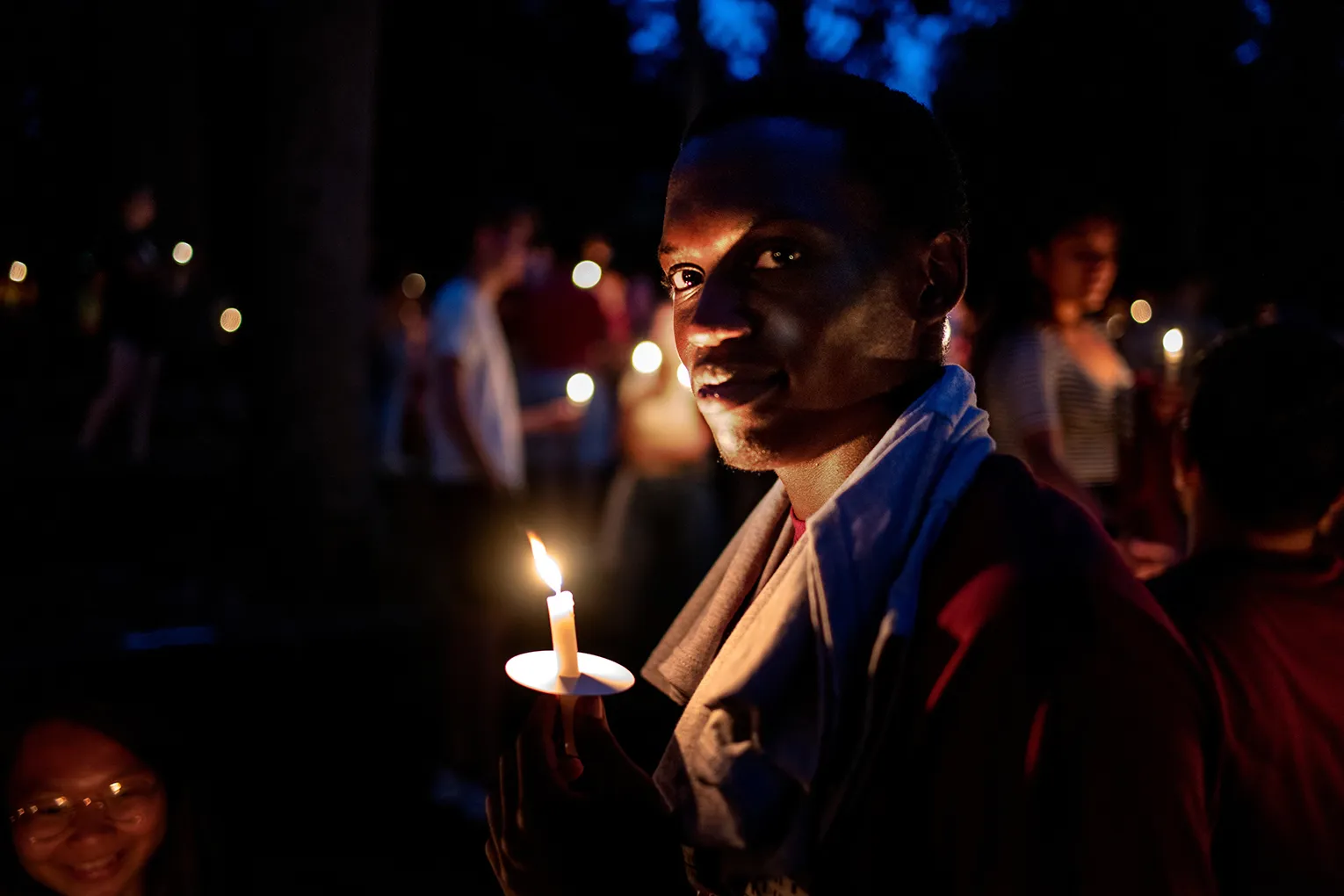Cloud Atlas and the Globalization of Cinema
Essay by Ben Rotko '25 for German Cinema Course
Cloud Atlas (dir. Tom Tykwer and the Wachowskis, 2012) exists in the middle of a spectrum. It is at once an independent, auteur passion project, and an eight-figure blockbuster. It is a product of both postmodern German cinema and Hollywood. Based on the 2004 novel by David Mitchell, Cloud Atlas follows six distinct stories set across six distinct settings. These six stories are linked thematically through the presence of recurring actors who play different roles in each timeline. “Internationalization is pertinent to all of cinema history,” and the “problem of ‘unprecedented’ mass distributability” is not a new one (Rosen 1996, p. 396, 383). However, factors such as economic globalization, media convergence, supranational organizations like the European Union, and the growth of English as a global lingua franca have made film production more international than ever. This makes it difficult to classify many films as being “from” one country or another. Cloud Atlas is an international film. It stars Hollywood megastars like Tom Hanks and Halle Berry in a plot that spans continents and centuries. It boasts a budget of over $100,000,000. At the same time, it is also a German film. It draws on existing tensions between the role of the actor as a celebrity and an artist, and the film follows a long line of German films that are deeply interested in history and memory. Through its creative casting and focus on global memory, Cloud Atlas repositions tenets of German cinema in a global context.
Cloud Atlas is not commonly thought of as a German film. After all, none of the main cast is German, and the film is almost entirely in English. Despite this, if this deeply international film has roots in any particular country, it is Germany. Co-director Tom Tykwer is German, and the film was originally announced as being directed by Tykwer with the Wachowskis writing the screenplay (Billington 2009). Only later were the Wachowskis announced as co-directors (Kroll 2011). In other words, the film was arguably Tykwer’s baby first and foremost. Tykwer is a darling of the German film landscape, once heralded as a candidate to succeed Rainer Werner Fassbinder as the country’s premier director (Cooke 2020, p. 139). Cloud Atlas was principally funded by German sources. The film received funding from the German Federal Film Fund and several German states, while another large portion of funding came from European Union sources. Lastly, the film was primarily filmed in Germany. Studio Babelsberg, near Berlin, served as the primary studio and production basecamp. Journalists described the film as the first attempt at a German blockbuster (Pidd 2011; Rodek 2011). One of the film’s producers described it as a “pure German film – and the most expensive ever” (Pidd 2011). The film’s producers view it as a German creation first and foremost, and being one of the most ambitious and expensive German films ever made was a point of pride to the production team.
The idea of “national cinema” has always been tenuous, especially in Europe. Scholars argue that we need to think of European cinema as a category unto itself, and that “German cinema has always been international and transnational” (Hake 2013, p. 113). Even the earliest German films featured individuals from countries like Switzerland and Denmark in key positions in front of and behind the camera, like Danish director Stellan Rye. While films produced primarily in a certain country may share stylistic, ideological, and technical characteristics, they are not insulated from their surroundings. The emphasis on national cinema in public consciousness and film scholarship ought to be understood as a defensive response to the prevalence of Hollywood (Hake 2013, p. 113). However, economic changes have made film production more globalized than it ever has been. Hollywood is not the singularity it once was. When Cloud Atlas was in production, Hollywood was still cash-strapped from the 2008 financial crisis. In an interview, Cloud Atlas producer Stefan Arndt notes that while Hollywood still holds significant cultural capital, its financial resources are not leaps and bounds ahead of the rest of the world, as it was in times past (Pidd 2011). This has upset the traditional paradigm of European cinema, enabling Europe to produce more ambitious and expensive movies. For most of modern filmmaking history, “‘European’ just as often identifies films made outside the commercial rewards and constraints of the box office” as it does films made in Germany, Italy, or Portugal (Elsaesser 2005, p. 485). Indeed, before Cloud Atlas, very few films were produced primarily in Europe with blockbuster budgets, and most of the ones that could be called blockbusters in terms of budget were French, such as the Asterix and Obelix series. At the same time, it would be incorrect to call Cloud Atlas a solely German film. Its cast is primarily American and British, and the film is in English. Cloud Atlas is both an independent art-house passion project and a blockbuster. It is both German and international. Jung-Bong Choi (2011) argues that “National cinemas and Hollywood are suspended in a mutual, albeit unequal, hostage situation, making the simultaneity of their collision and collusion unavoidable” (p. 181). Cloud Atlas is an example of the “collision” and “collusion” that Choi is describing.
Cloud Atlas draws on a longstanding tension in German cinema: that between the ambitious movie star and the avant-garde artistic actor. In the earliest days of German filmmaking, the line between actor and role was often blurred. Sabine Hake (2008) notes that “the film star blurred the boundaries between actor and role and created a much needed sense of continuity among individual films and genres.” Hake describes this “star phenomenon” as a “cult of personality” which also enabled “new possibilities for viewer identification through decidedly voyeuristic scenarios” (p. 16). However, during the Autorenfilm era of the 1960s-1980s, the influence of movie stars was downplayed. It was believed that “a star is a shallow individual chasing transitory fame, while a ‘true’ actor is a soul-searching artist longing for eternal truth” (Hagener 2020, p. 109). Autorenfilm, which translates literally to “author’s film” and describes films written and directed by the same person, is roughly synonymous with auteur cinema. These two schools of thought correspond to the tension between blockbuster films and arthouse, auteurist cinema that has existed throughout German film history. Cloud Atlas embodies this tension due to its very nature. It is an independent film, but it’s also one of the most expensive independent films ever made. It features some of the most famous actors on the planet but casts them in many weird and unusual roles. Due to its unique casting and structure, Cloud Atlas can marry these two trends in casting. It is undeniable that a large part of the appeal of Cloud Atlas is seeing beloved Hollywood stars like Tom Hanks and Halle Berry play multiple, drastically different roles within the same film. What Hake describes as a “cult of personality” can also be understood as an actor’s box-office draw. Many people choose to watch a film starring Tom Hanks because Tom Hanks is in the film. He is one of the most prolific and beloved movie stars in the world. Cloud Atlas takes this audience expectation and simultaneously delivers on it and subverts it.
Tom Hanks’s roles in the film serve as a microcosm of how Cloud Atlas carries both of these acting trends. Who is Tom Hanks? In many roles, he is lovable, roguish, and a bit of a scamp. His characters often get in over their head and have to work their way out of difficult situations using their unique traits. Big (dir. Penny Marshall, 1988), Forrest Gump (dir. Robert Zemeckis, 1994), Cast Away (dir. Robert Zemeckis, 2000), and The Terminal (dir. Steven Spielberg, 2004) exemplify this archetype. In other roles, Hanks steps into the role of authority figures. Saving Private Ryan (dir. Steven Spielberg, 1998), Toy Story 3 (dir. Lee Unkrich, 2010), Captain Phillips (dir. Paul Greengrass, 2015), and Pinocchio (dir. Robert Zemeckis, 2022), are examples of this other trend in Hanks’s filmography. Because of his global fame, audiences enter a Tom Hanks film with some preconceptions of what to expect. In keeping with its dual nature, Cloud Atlas delivers some very typical Tom Hanks characters and some very un-Hanks-like characters.
Hanks’s most prominent role in Cloud Atlas comes in the 2321 time period, where he plays the protagonist, Zachry Bailey, a gatherer from a valley tribe. Zachry is, in many ways, a very Hanks-y character. His dialogue, spoken in a 2321 speculative evolution of English, is a little twangy, almost evocative of Forrest Gump. Like many Hanks characters, Zachry is compassionate and kind, even if he isn’t necessarily book-smart. He starts the film as a coward, hiding behind a rock while his brother-in-law is killed by a tribe of cannibals, but throughout the film, he learns the importance of bravery and sacrifice. Zachry is extremely protective of his daughter, like many of his authority figure characters. He has a strong moral compass, constantly fighting against the temptations of a demon called Old Georgie (Hugo Weaving). Put simply, Zachry is the most protagonist-coded of the six protagonists. He is the only protagonist who “comes closest to uncovering a more holistic understanding of how his own time and place sit within a greater framework of alternate histories” (Ng, 2015, p. 117). Zachry’s arc has the most resolution, and his narration opens and closes the film. Hanks’s performance as Zachry creates, as Hake (2008) puts it, “a much-needed sense of continuity among individual films and genres” (p. 16). Hanks is most recognizable as Tom Hanks in this role, both in character and in appearance, with minimal cosmetic hair and makeup compared to his other roles in the film. Cloud Atlas experiments with its narrative structure and casting, so having Tom Hanks play an archetypically Tom Hanks character in the most narratively experimental portion of the film, set furthest in the future, works to anchor the viewer.
Zachry is a stark contrast to Hanks’s other major role in the film. In the 1849 time period, set in the Chatham Islands and the ensuing voyage back to the United States, Hanks plays Dr. Henry Goose. Goose is a quack doctor who weasels his way onto a ship under the pretense of treating Adam Ewing (Jim Sturgess) for a parasitic worm. It is later revealed that Dr. Goose has been slowly poisoning Ewing with arsenic, with the ultimate goal of stealing the gold that Ewing has in his trunk. Hanks is borderline unrecognizable in the role. If viewers did not know that Tom Hanks was in Cloud Atlas and looked solely at Dr. Goose, they might not realize it was him. With his strong forehead and balding visage, Dr. Goose is everything a typical Tom Hanks character is not. Goose is sweaty and twitchy; he speaks nervously and excitedly. His sing-song speech patterns make every line of his dialogue sound like reciting a nursery rhyme. As he feeds the delirious Ewing arsenic, he says, “Come on now, Adam, handsomely does it.” Goose monologues like a cartoon villain, gleefully describing his murder plot to the barely conscious Ewing. Hanks had never played a villain before Cloud Atlas. Despite being a Hollywood movie star, his performance as Dr. Goose follows the New German Cinema acting tradition of sinking into a role and being borderline unrecognizable in it. Think of Klaus Kinski in Werner Herzog’s Aguirre, the Wrath of God (1972) and Nosferatu the Vampyre (1979). Kinski plays radically different characters in the two films and also appears incredibly different. The actor’s performance is subservient to the director’s vision. Through its unique approach of casting actors in multiple roles, Cloud Atlas delivers on audience expectations of movie stars while simultaneously subverting them. It splits the difference between being more actor-driven, like Hollywood, and less actor-driven, like New German Cinema.
German film has long been deeply focused on history and memory, collective memory, and reckoning with the past. Fueling much of this is a decades-long conversation on how to remember, understand, and learn from the genocide committed by Nazi Germany during World War II. Post-war films were “more concerned with moving forward, with reconstructing the nation rather than reconsidering its past” (Rentschler 2010, p. 14). Many of those films were shot amongst the rubble of bombed cities, the shattered urban environments providing a constant reminder of what had happened. The past could not be changed, and the nation had to find a way to move forward. The idea of physical objects being laced with memories can be taken further. In her book, Prosthetic Memory, Allison Landsberg argues that mass culture and new technologies open up new possibilities for empathy through the recorded memories of others. Landsberg writes that “Mass culture has had the unexpected effect of making group-specific cultural memories available to a diverse and varied populace” (Landsberg 2004, p. 11). Through “textual artifacts,” individuals “answer central questions... [and] make meaning of their lives and histories” (Mezey 2011, p. 17). Cloud Atlas takes this idea and makes it literal.
In Cloud Atlas, the six different periods are linked by forms of media that are found by people in future periods. In 1936, Robert Frobisher (Ben Whishaw) reads Adam Ewing’s diary. In 1973, Luisa Rey (Halle Berry) listens to music composed by Forbisher and reads his letters. In 2012, Timothy Cavendish (Jim Broadbent) reads a screenplay based on a novel written by Luisa. In 2144, Sonmi (Doona Bae) watches a film based on Cavendish’s ordeal. Finally, in 2321, Sonmi’s final video message becomes the basis for the religion practiced by Zachry’s people. Rather than being oral tradition or collective memory, these ideas are passed down through media objects, whether they be diaries or vinyl records. This reflects a postmodern understanding of memory, as Landsberg outlines, where our memories become intertwined with the technologies with which we record them, making them accessible. The memories are also changed in unintended ways. Frobisher’s sheet music becomes a record, Luisa’s journalism becomes a novel that eventually becomes a screenplay, and Sonmi’s video message becomes religious text. While the message is changed by the medium, the meaning remains the same. To pull a line from the original novel, “It is not the unflattering light they shed on a pliable young Rufus Sixmith that bothers Luisa, but the dizzying vividness of the images of places and people that the letters have unlocked. Images so vivid she can only call them memories” (Mitchell 2004, p. 120). The letters give Luisa Rey a “transgenerational, transcontinental connection with Robert Frobisher,” despite never having met the man (Mezey 2011, p. 26). Cloud Atlas shows how this can become a force for change across centuries. When Sonmi watches the film about Cavendish, she is inspired by his escape from the nursing home in which he was trapped. This spurs her to take charge of her destiny and escape from her own imprisonment, which results in her wisdom being revered as a religious doctrine in the future. Some of these instances are crucial to the plot: Sonmi would not have been inspired to escape if she had not watched the film. Others are blink-and-you’ll-miss-it easter eggs, such as the screenplay that Cavendish reads. There is not much in the way of editing or direction that draws the audience’s attention to these pieces of media. Instead, the audience is asked to identify and remember these connections. While “each narrative thread could be seen as the development of one mode of civilization at the expense of the previous,” Cloud Atlas’s structure disrupts this assumption (Ng, 2015, p. 118). By cutting between periods rather than proceeding chronologically, the film demonstrates that progression and memory are not linear.
Through this chain of prosthetic memory across centuries, Cloud Atlas places itself within the lineage of German film and its focus on memory but reorients that focus towards a global context. Rather than trying to reconstruct a future for a particular nation, Cloud Atlas reconstructs a future for all of humanity. This vision of the future is not utopian, per se, but “all six sections are interrupted at just the right moment to instill hope, even though there are very real uncertainties” (Ng 2015, p. 115). This future is global and post-national. While the 2144 segment is set in Neo Seoul, the film depicts national boundaries as having broken down. We hear a language spoken that is described as a pidgin of Chinese and Korean. Then, in Zachry’s time, our present notions of nation and race have all but disappeared. The demon who tempts Zachry, Old Georgie, at one point specifically tries to reinsert 21st-century notions of race into 2321. Old Georgie says “You judasin’ your kin for a piece of ass. She ain’t your tribe; she ain’t even your color.” Zachry rejects this and embraces Sonmi’s message: “Our lives are not our own. From womb to tomb, we are bound by others, past to present.” Thus, while Cloud Atlas embraces German cinema’s focus on memory, it does so in a different way, showing how memory can be a force for deconstructing the nation rather than reinforcing it.
Cloud Atlas demonstrates the complexities of what “national cinema” looks like in the 21st century. Through splicing together different temporal and geographic settings, the film envisions a transnational past, present, and future. It draws on two trends in casting that define German filmmaking, both the star-driven cinema that defined early German cinema, and the anti-celebrity trends of New German Cinema, and synthesizes. Through its unique approach to casting, Cloud Atlas draws on both of these trends. The film also follows the German national cinema tradition by focusing on memory. The multi-temporal nature of the story means that memory, both individual and collective, plays a crucial role in the film’s themes. It demonstrates the ability for memory to be prosthetic, to be encoded within objects and media. This argument is also supported by the box office. Cloud Atlas grossed $12.7 million in Germany (Hoad 2013), which is far better than it did in the United States, considering the relative market sizes. According to data from Box Office Mojo, Cloud Atlas made more money on its opening weekend per theater in Germany than in the United States. At the same time, the film is still in English, still stars primarily American and British actors, and was still primarily distributed, albeit not produced, by an American studio (Warner Bros. Pictures). Cloud Atlas is German, it is American, it is international, and it is also something else entirely. While it focuses on memory like many German films, it positions memory as something that can dissolve the nation-state, rather than reconstruct it. It’s a global film, with a vision of a global past, present, and future.
Works Cited
Anon. n.d. “Cloud Atlas.” Box Office Mojo. Retrieved December 7, 2024 (https://www.boxofficemojo.com/release/rl3539043841/weekend/).
Billington, Alex. 2009. “Tom Tykwer Adapting Cloud Atlas with Wachowski Brothers | FirstShowing.Net.” ENJOY THE MOVIES. Retrieved December 2, 2024 (https://www.firstshowing.net/2009/tom-tykwer-adapting-cloud-atlas-with-wachowski-brothers/).
Choi, JungBong. 2011. “National Cinema: An Anachronistic Delirium?” The Journal of Korean Studies 16 (2): 173–91.
Cooke, Paul. 2020. “Looking for Fassbinder: Denationalizing Authorship.” Pp. 139–45 in The German Cinema Book, edited by T. Bergfelder, E. Carter, D. Göktürk, and C. Sandberg. London: The British Film Institute.
Elsaesser, Thomas. 2005. “European Cinema as World Cinema: A New Beginning? [2005].” Pp. 485–514 in European Cinema, Face to Face with Hollywood. Amsterdam University Press.
Hagener, Malte. 2020. “German Stars Since Reunification.” Pp. 107–12 in The German Cinema Book, edited by T. Bergfelder, E. Carter, D. Göktürk, and C. Sandberg. London: The British Film Institute.
Hake, Sabine. 2008. German National Cinema. 2nd ed. London: Routledge.
Hake, Sabine. 2013. “German Cinema as European Cinema: Learning from Film History.” Film History 25(1–2):110–17. doi: 10.2979/filmhistory.25.1-2.110.
Hoad, Phil. 2013. “Cloud Atlas: How Hollywood Failed to Put It on the Map.” The Guardian, February 20.
Kroll. 2011. “‘Cloud Atlas’ Gathers with Tom Hanks.” Variety, April 12.
Kulish, Nicholas, and Michael Cieply. 2011. “Around the World in One Movie: Film Financing’s Global Future.” The New York Times, December 6.
Landsberg, Alison. 2004. Prosthetic Memory: The Transformation of American Remembrance in the Age of Mass Culture. New York: Columbia University Press.
Mezey, Jason Howard. 2011. “‘A Multitude of Drops’: Recursion and Globalization in David Mitchell’s Cloud Atlas.” Modern Language Studies 40 (2): 10–37.
Mitchell, David. 2004. Cloud Atlas. London: Sceptre.
Ng, Lynda. 2015. “Cannibalism, Colonialism and Apocalypse in Mitchell’s Global Future.” SubStance 44 (1): 107–22.
Pidd, Helen. 2011. “Cloud Atlas to Be Filmed in Berlin as City Eyes Starring Role in Movies.” The Guardian, June 22.
Rentschler, Eric. 2010. “The Place of Rubble in the ‘Trümmerfilm.’” New German Critique (110): 9–30.
Rodek, Hanns-Georg. 2011. “Der 100.000.000 Dollar Film - WELT.” DIE WELT. Retrieved December 3, 2024 (https://www.welt.de/channels-extern/ipad_2/kultur_ipad_2/article13443685/Der-100-000-000-Dollar-Film.html).
Rosen, Philip. 1996. “Nation and Anti-Nation: Concepts of National Cinema in the ‘New’ Media Era.” Diaspora 5 (3): 375–402. doi: 10.3138/diaspora.5.3.375.
Roxborough, David. 2012. “‘Cloud Atlas’ Delivers Solid Euro Opening.” Hollywood Reporter, November 19.
Selisker, Scott. 2014. “The Cult and the World System: The Topoi of David Mitchell’s Global Novels.” NOVEL: A Forum on Fiction 47 (3): 443–59.
Wachowski, Lana, Tom Tykwer, and Lilly Wachowski, dirs. 2012. Cloud Atlas. Warner Bros. Pictures, X-Verleih.



